All about carved wood chess
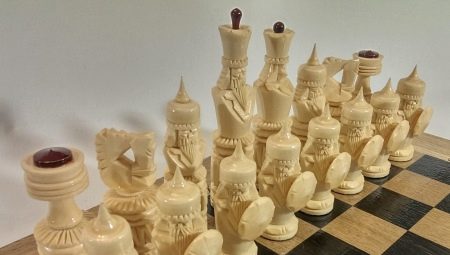
The game of chess is a popular logic board game between two opponents. And if you want to surprise a chess lover with an unusual gift, you can present handmade pieces. In the article we will talk about carved wood chess.
Peculiarities
The game requires a board of 64 cells of light and dark colors and special pieces that players move around the field. Figures for the game are also divided into light and dark. There are 32 of them, a set for one player consists of 16 pieces: pawns (8 pieces), knight (2 pieces), bishop (2 pieces), rook (2 pieces), queen (1 piece), king (1 piece). Various materials are used for the manufacture of figurines, it can be wood, plastic, marble, metal, ivory, onyx and polystone. Carved wood chess sets have become widespread among players, which are also suitable as a gift.
With its originality, such chess will attract any person, because painstaking work is needed to create it. Handicraft cannot be compared with factory production; every master puts a piece of his soul into each figurine. Such products can be manufactured for up to several months. Wooden chess can not only become a decoration for collectors' houses, but also serve as a game.
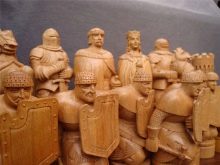
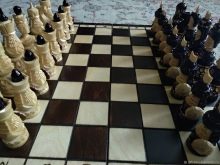
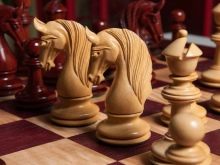
Instruments
To start carving wood, the master needs a certain set of tools - these are various chisels and materials for polishing and creating decor for future figures. Chisels are indispensable tools for processing and creating wood decor, in addition, professional carvers can make special curly cutters especially for themselves. Chisels differ among themselves in the shape of the cutting surface.
- Straight. The tool is focused on the initial finishing of wooden blanks and creating simple recesses on them. The name speaks for itself - straight working blade.
- Oblique chisel. The blade of this tool is cut obliquely at a 45 degree angle. Serves also for the initial finishing of wood and the formation of longitudinal lines.
- Suitable for V-groove threads corner chisel, has the form of two paired cutting surfaces, practically closed with each other.
- Semicircular - the most famous and widespread species. Needed for drawing serifs and patterns, which can be of any complexity.
- Clucarza - its shape is similar to a semicircular chisel, only its working blade is rounded not along one end, but also along the rod itself.
- Caesarics - the same cranberry, but with a very small blade (only 2 - 4 millimeters).
- Shtikheli with oblique cutter - are needed to create small depressions.
- Reverse chisels or, in simple terms, tatyanka - have a convex notch and serve to create a relief protruding above the canvas itself.
- Rivets - chisels of a very small size, with the same small and thin blade. Needed to give the ornament clearer contours.
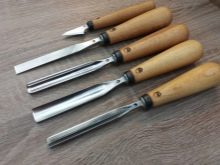
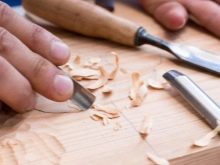
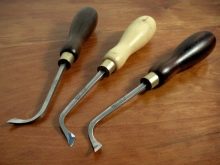
For grinding products, you will need sandpaper (sandpaper). Depending on the grain size, only 3 types of skins are distinguished.
- Coarse-grained - needed to remove old coatings, such as paint or varnish.
- Medium-grained - her help is necessary at intermediate stages of work, leveling surfaces.
- Fine-grained - final grinding work is carried out with it, all irregularities from previous sanding are removed.
For chess, only the last two types of sandpaper are used.
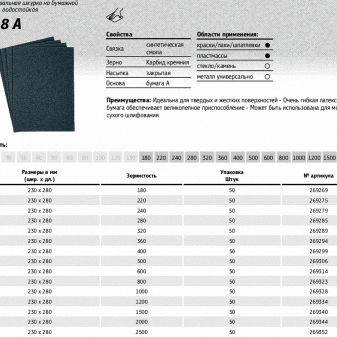
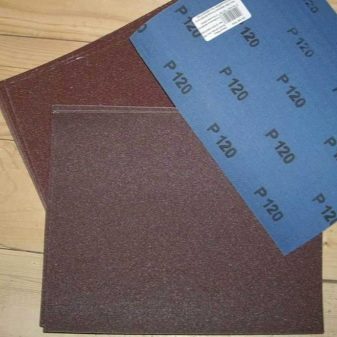
Execution technology
There is no special kind of wood for making chess, the carver chooses it himself, relying on the complexity and volume of work. For inexpensive models, pine, birch, aspen or linden are used. For premium products - oak, beech or walnut. To develop a technology for performing and start making chess, you should prepare a sketch. It is needed so that later the figures do not differ and are of the same size. The drawing begins with the choice of the height of the future figure and the outline of the base.
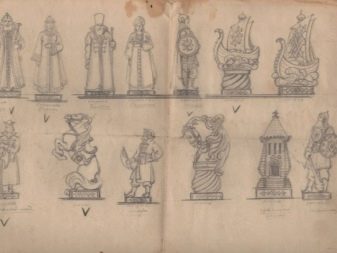
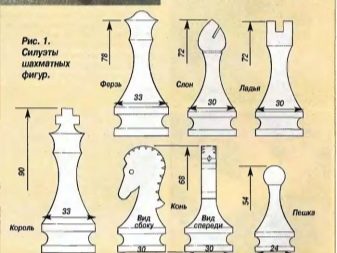
They draw the desired stand, already at this stage they create the edges and bends of the pedestal. Next, the center is marked and the vertical axis is drawn. This is done to keep the figure straight and symmetrical. Then the top is drawn (head, hat, face, and so on). It all depends on the imagination of the master, because it is he who designs the body parts, cloak, shield, sword, various patterns, etc. The next step is drawing the template itself for the workpiece. For this, around the main sketch drawing, a kind of "allowances" are made.
Blanks are cut from square-sectioned wooden blocks. Since 32 pieces are needed for the game, there will be the same number of blanks. A ready-made stencil is transferred to each face (for a horse, two drawings are needed - one on the side, and the second in front). Then the outlines of the figures are cut out along the profile of the transferred sketch. Having cut the figure on one side, the workpiece is turned over and the next face is cut out. The preparatory work has been completed, the approximate outlines of future chess are already visible, now the most creative moment has come - carving.
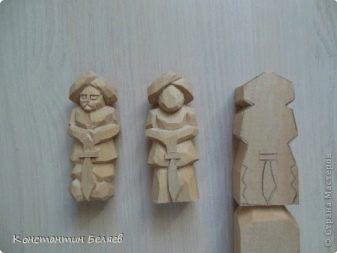
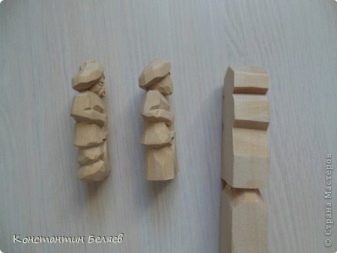
The most popular technology for making chess with their own hands for beginners has become the technique of turning from plywood. For this, ready-made sketches are transferred with a pencil onto a prepared piece of plywood, its desired thickness is 3 millimeters. Next, the workpieces and holes are carefully cut out with a jigsaw along the contour - they can be made using a thin drill or an awl. You will also need to make 32 rounds, reminiscent of checkers - they will serve as supports for chess.
After all the figures are cut out, grinding begins. - it is needed in order to remove extra pieces of wood, jags from the edges.The next stage is assembly, the finished parts are connected to the base - you can fasten it with glue. The figures are divided in half, 16 pieces must be painted in a dark color, for example, with acrylic paint. After the paint has dried, all chess pieces, including white ones, are varnished.
It is better to apply 2 layers, then the finished shapes will look more presentable and graceful.
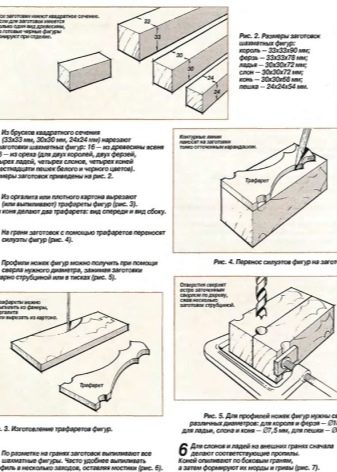
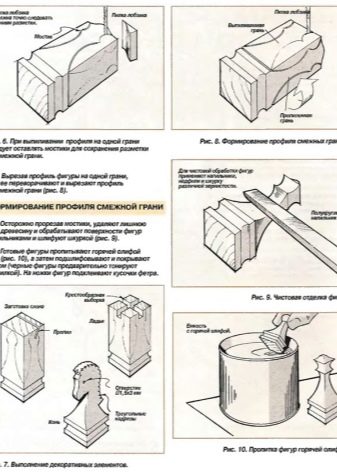
Chess is ready, it remains to make a field for the game - a chessboard. A sanded square piece of plywood is pre-varnished, this is done immediately, because on an unvarnished surface, the paint will begin to creep between the fibers of the tree, and clear beautiful squares will no longer work. Then a stencil is applied - you can use masking tape. Having pasted it on the future chessboard, they draw 64 identical squares and, using a clerical knife, carefully cut out the extra pieces.
Now, like the figures, the chessboard can be painted with acrylic paint... After it has dried, remove the stencil from the remaining adhesive tape and varnish again. The edges of the board can be decorated with window glazing bead, its price is not high. For this, the glazing bead is also attached in the form of a frame on four sides with the help of glue.
This was the simplest example for novice masters. By starting small, you can achieve higher results and improve your skills.
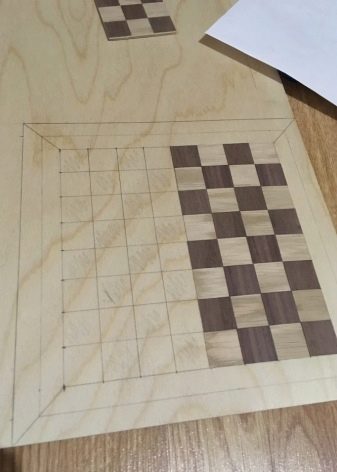
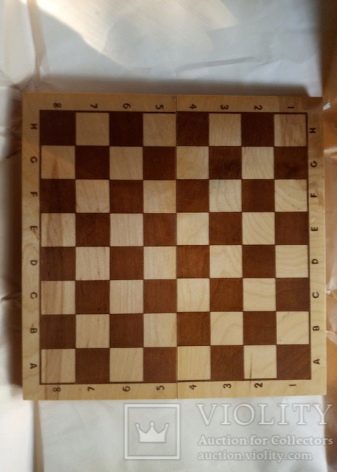
A crash course in chess carving is presented below.








